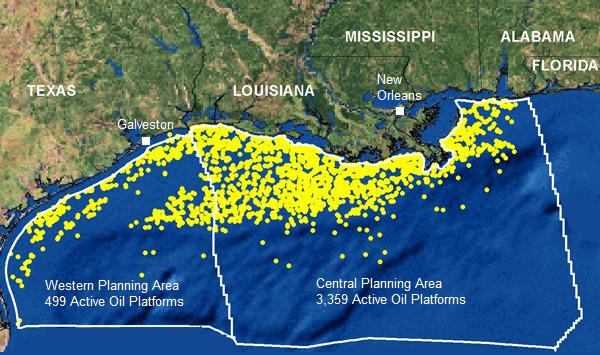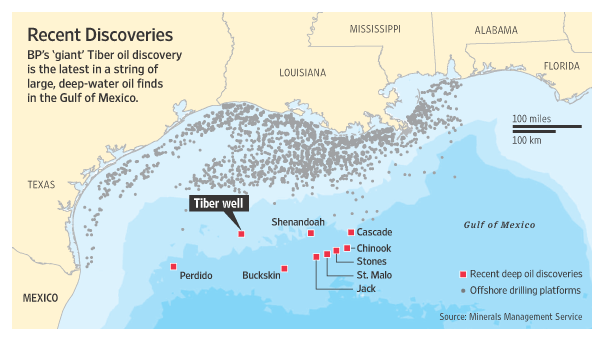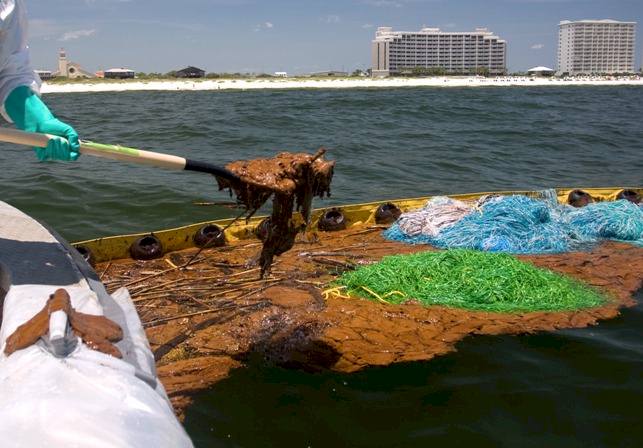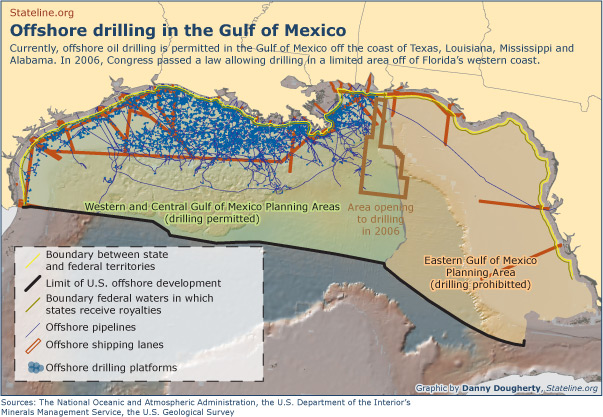"Obama could have prevented the current disaster when the Centre for Biological Diversity won an injunction to stop Deepwater Horizon drilling in 2009. Instead he used extralegal measures to sway the court to back off in exchange for a promised environmental impact plan which he never produced," says Themis artist Ruffian Angel.The Mexican Gulf Ecological DisasterLeak estimates reached as high as 60,000 barrels per
day mid June as oil Industry/politicians scramble to change their stories.
< Previous | Next > President Obama & The Energy System Are Corrupt
U.S. President Obama was told by a U.S. Court not to allow Deepwater Horizon to drill.
Obama
promised a study on the environmental risks in exchange for a stay of a court
injunction that stopped the drilling in the Gulf of
 Mexico last year.
Instead of doing an environmental impact study, and in violation
with the National Environmental Policy Act each major oil company buying leases
last year for the Mexican Gulf submitted fake disaster relief
plans, each one being a reworked copy passed from company to company secretly by
current Administration officials. Mexico last year.
Instead of doing an environmental impact study, and in violation
with the National Environmental Policy Act each major oil company buying leases
last year for the Mexican Gulf submitted fake disaster relief
plans, each one being a reworked copy passed from company to company secretly by
current Administration officials.The promises a change of party would bring to the White House with a liberal Democrat at the helm have gone out the window. It seems that 'Big Oil' still runs Washington DC and probably the globe and that no politician is excempt nor can he/she be trusted where oil, energy or money are concerned. Considering the tone of Obama's address to the nation on 15 June 2010, it is ironic that at about the same time as the Deepwater Horizon explosion in 2010, in 2009, the the Obama administration helped intervene in court to save the Deepwater Horizon well by having the decision in favour of the Center for Biological Diversity reversed. Obama supported the reversal of a court order that would have halted offshore oil drilling in all the Gulf of Mexico. Obama’s Interior Secretary Ken Salazar, who has long had close ties to the industry, specifically cited BP’s Deepwater Horizon operation as one that should be allowed to go forward. A Washington DC Appeals Court ruled in April 2009 that the George Bush administration’s 5-year plan for offshore oil and gas drilling for the period 2007-2012 was not based on a proper review of the environmental impact of the drilling. A few days before the ruling, the Obama administration had granted BP a categorical exclusion,
It was the American Petroleum Institute, the oil industry trade group, intervened to reverse the court order, and was backed by the Obama Administration.  Kierán Suckling, executive director and founder the Center for Biological Diversity, which was involved in the original lawsuit, said that Salazar filed a special motion asking the court to lift the injunction, and he cited the BP drilling several times by name in the request. In July 2009, the court ruled that drilling in both the Gulf and off the coast of Alaska could continue, on the condition that the administration conduct a study of the potential environmental risks. This study has yet to be completed. Shell Oil, by summer's end in 2010 will start deep water drilling off the coast of Alaska and nobody has any idea of how bad the environmental impact could be or what could happen if another leak, and there will be other leaks, floods the Arctic with crude oil. Salazar, last year had praised the reversal decision, saying it allowed the administration to go forward with a comprehensive energy plan, including the BP project and a sale of leases for drilling in the Gulf, which leases were sold last year (2009). The deep-water successes sparked new enthusiasm that oil production in the Gulf of Mexico will rise. The U.S. Minerals Management Service, which oversees offshore oil leases, predicted last year that 1.88 million barrels of oil a day will be produced in 2013, up from a storm-battered 1.14 million barrels a day in 2008. In 2010, about 14% of crude oil production in the Lower 48 states will come from four deepwater Gulf oil fields, two of which, Atlantis and Thunder Horse, are operated by BP. The technological wizardry required to suck oil from the ancient rocks, known as the Gulf's lower tertiary, underscores how extraordinarily expensive it is to develop these prospects. To drill each well costs about $200 million. And a prospect often requires several wells, plus expensive pipelines and floating facilities. Still, the Gulf of Mexico has emerged as a major area of interest for the Western oil companies that have been locked out of many of the world's largest untapped resources in the Middle East and Russia. Other recent finds in Uganda, Kurdistan and off the coast of Ghana are estimated to be several billion barrels of oil, while the Gulf of Mexico and Brazil contain tens of billions of barrels. Nothing compares to the Gulf of Mexico. There is a gold rush boom in the Mexican Gulf. Even as MC252 spews oil, the Interior Department’s Minerals Management Services (MMS) has continued to grant "categorical exclusions" to oil and gas companies, allowing them to bypass environmental studies. The administration has publicly announced that no new offshore drilling grants will be issued until a review, to be completed by the end June but that has had no meaning whatsoever. Despite the so-called moratorium, at least 27 exemptions have been granted, as the President speaks from the Gulf and on National TV, including one for a BP exploration plan for drilling at more than 4,000 feet. Another exemption was granted to Anadarko Petroleum Corporation for an exploration plan at more than 9,000 feet. The Deepwater Horizon was drilling at about 5,000 feet. MMS has always received widespread criticism for corrupt involvement with the oil industry, with claims ranging from inappropriate interactions and relationships with oil and gas representatives to perceived bias toward the industry, leading to the agency's alleged failure to enforce any environmental and safety standards. Recently the head of the MMS was fired for wrong-doing, an action that was shrouded in mystery. The whole system is corrupt from the bottom up. MMS and Obama can have the 100,000 gallons of crude per hour pouring from MC252 into the Atlantic Ocean. It would seem that off-shore oil drilling risks damaging our oceans for the sake of having more fossil fuels with which we then damage Earth's atmosphere all the while feeding a greedy, corrupt administration operating from Washington with tentacles reaching around the globe.  Pursuing the Bush and Obama-Administration initiative for deep-water offshore oil drilling without any disaster recovery plan, the TransOcean-owned "Deepwater Horizon" drilling rig had been boring the oil well known as MC252 for British Petroleum, located in 5,067 ft of water in United States Coastal waters about 50 miles from the coast of Louisiana. Working with Halliburton Inc., TransOcean Inc. drilling crews were planning to leave the MC252 site in order for another unit, a completion rig, to come into place to take over and prepare the well to go into production.(see Explosion No Surprise). After an explosion on 20 April that killed 11 workers aboard the Deepwater Horizon , the rig sunk two days later leaving a tremendous flow of crude gushing from the broken and bent risers that had slid to the bottom of the ocean at the marine well head . Capping a broken, twisted, crude-oil-gushing sea-bed riser is no small feat at depths of roughly one mile below the surface where pressures are crushing. Stopping the thousand-barrel-per-hour flow of oil from a bore that has been drilled almost 4 miles below the ocean surface is just not going to happen except for the absolute luckiest of operators. That's one of the risks that is taken when the greed for oil far exceeds the desire for responsible ecology and no plan to remedy a disaster. The MC252 (Maconda 252) well will not stop until the reservoir is depleted. That could take many years. British Petroleum (BP) must in fact control the flow and draw it through pipes to container vessels and eventually bring it to market. BP's Live Feed From Remotely Operated Vehicles at MC252By June 3, workers at the MC252 (Macondo 252 ) site had tried all the simpler quick-fix options without success. Capping and controlling some of the flow is the current project while BP moves equipment into place to drill wells into the sea bed to the same pool feeding MC252 (Macondo 252 )from nearby and take the pressure off the out-of-control well.The relief wells are drilled straight down into the sea bottom, parallel to the Macondo 252 well bore for several thousand meters and then angled to intersect the original wellbore at about 4,000 meters below the seafloor. It is expected to take another two months for BP to reach this depth, which is just above the oil reservoir, a subsurface pool of crude and natural gas sandwiched between layers of rock. Meanwhile the process of capping and bleeding off a quantity of oil continues. In a televised address to the U.S. nation, President Obama said on June 15 that 90% of the leak will be captured n a couple of weeks. Some of the oil is being stored ship-board until offloaded to barges and taken to refineries, and thousands of barrels have been burned off on the surface becasue storage capacity has been limited aboard the ships on site. On June 5, the broken mess of twisted riser pipe was cleanly severed from the lower marine riser and all the twisted pipe that had stymied some of the flow. This leaves BP with the full raging flow from the well to deal with but at the same time, a clean diameter upon which to operate. By June 6 , after 3 failed attempts, a quasi-cap was put in place with a channelling riser taking some of the crude, between 5 and 10% of the total leak away from the marine well to the surface. This a leaky, lossy process which is done with a deliberately loose connection between the new riser and the rubber base of the newly placed well-cap. The tecnicians operating robotic arms to perform the job must carefully avoid another explosion which could happen if they contained the leak too fast. Because this capping/relief drilling operation is many-faceted and still in it incipient stages, the flow of crude oil into the ocean at this time is conceivably much worse than it has been at any time since the Deepwater Horizon Explosion. Cleaning up the debris of bent riser pipe which was restricting the leakage has left the well unrestrained. Cutting the nearly two-foot diameter pipe wide open at the lower marine riser unleashes the full force of the man-made volcanic oil gusher and would have increased the now unrestricted marine well-head flow by roughly 15 to 25 % to an estimated 2400 barrels per hour or more, 60 thousand barrels or more per day. Oil wasn't in the water before greedy men came along and it shouldn't be in the ocean now. The risk of this happening again and again is real. The yellow dots in the picture beloware oil wells.  The oil leak is getting much worse for the moment.  'Moran Environmental' Contractor Cleaning Up The Crude As It Nears Orange Beach in Alabama Photo © BP p.l.c. In another shocking news item from the Gulf of Mexico, Moran Environmental is keeping out U.S. Non-Governmental Institutions like the Human Society, National Wildlife Society and helpers from all around the world willing to hep save wildlife on a voluntary basis. BP is paying Moran and it doesn't want volunteers poaching its territory. The Unions of workers paid by BP to clean up shore lines have lobbied Washington successfully to have the U.S. coast guard turn away Mexican, Canadian and other ships volunteering to help with the booms and other oil-spill clean-up apparatus. This entire process suggests that the costs to the environment are absurdly high. Deep-water oil drilling risks damaging our oceans for the sake of having more fossil fuels with which to damage Earth's atmosphere.  < Previous | Next > * An estimated 60,000 Barrels per day / 24 = 2500 barrels per hour @ 42 US gals per barrel = 105,000 thousand gallons per hour -Ruffian.Angel at Themismusic.com |


